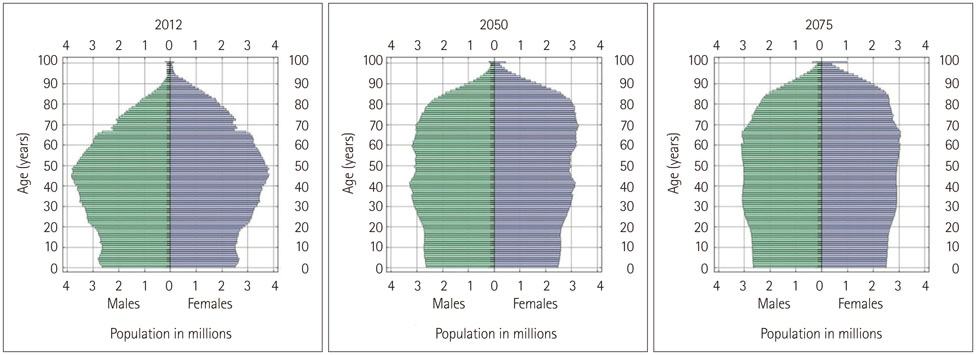J Clin Neurol.
2016 Oct;12(4):441-445. 10.3988/jcn.2016.12.4.441.
Projected Numbers of Ischemic Strokes Recorded in the Austrian Stroke-Unit Registry from 2012 to 2075
- Affiliations
-
- 1Research Office, Biostatistics, Paracelsus Medical University Salzburg, Salzburg, Austria. Wolfgang.Hitzl@pmu.ac.at
- 2Department of Neurology, Christian Doppler Clinic, Paracelsus Medical University Salzburg, Salzburg, Austria.
- 3Research Institute for Neurointervention, Paracelsus Medical University Salzburg, Salzburg, Austria.
- 4Department of Public Health Technology Assessment, UMIT-University for Health Sciences, Medical Informatics and Technology, Hall.i.T., Austria.
- 5Department for Clinical Neurosciences and Preventive Medicine, Danube University, Krems, Austria.
- 6Division of Neuroradiology, Department of Radiology, Paracelsus Medical University Salzburg, Salzburg, Austria.
- KMID: 2385108
- DOI: http://doi.org/10.3988/jcn.2016.12.4.441
Abstract
- BACKGROUND AND PURPOSE
This study analyzed the number of patients with ischemic strokes recorded in the Austrian Stroke-Unit Registry with the aim of projecting this number from 2012 to 2075 and to highlight that the Austrian health system will face a dramatic increase in older patients within the next few decades.
METHODS
Current demographic information was obtained from EUROSTAT, and information on age- and sex-stratified 1-year incidence rates of ischemic stroke were obtained from the Austrian Stroke-Unit Registry. Sensitivity analysis was performed by analyzing the projections based on predicted ageing, main, and growth population scenarios, and with stratification by age and gender.
RESULTS
The total number of ischemic strokes recorded in the Austrian Stroke-Unit Registry was 8,690 in 2012 and is expected to increase to 15,826, 15,626, or 18,134 in 2075 according to the ageing, main, and growth scenarios, respectively. The corresponding numbers of patients are projected to increase or decrease within different age strata as follows (100%=number of registered ischemic strokes in 2012): 0-40 years, 100%/99% (males/females); 40-50 years, 83%/83%; 50-60 years, 98%/97%; 60-70 years, 126%/119%; 70-80 years, 159%/139%; 80-90 years, 307%/199%; and 90+ years, 894%/413%.
CONCLUSIONS
The ageing population in Austria will result in the number of patients increasing considerably from 2012 to 2075, to 182%, 180%, or 208% (relative to 100% in 2012) according to the ageing, main, and growth scenarios, respectively; the corresponding value among those aged 80+ years is 315%, 290%, or 347%. These figures demonstrated the importance of improving primary preventive measures. The results of this study should provide a basis for discussions among health-care professionals and economists to face the future large financial burden of ischemic stroke on the Austrian health system.
Keyword
Figure
Reference
-
1. Lopez AD, Mathers CD, Ezzati M, Jamison DT, Murray CJ. Global and regional burden of disease and risk factors, 2001: systematic analysis of population health data. Lancet. 2006; 367:1747–1757.
Article2. WHO publishes definitive atlas on global heart disease and stroke epidemic. Indian J Med Sc. 2004; 58:405–406.3. Di Carlo A. Human and economic burden of stroke. Age Ageing. 2009; 38:4–5.
Article4. Allender S, Scarborough P, Peto V, Rayner M, Leal J, Luengo-Fernandez R, et al. European Cardiovascular Disease Statistics 2008. Brussels: European Heart Network;2008.5. Gustavsson A, Svensson M, Jacobi F, Allgulander C, Alonso J, Beghi E, et al. Cost of disorders of the brain in Europe 2010. Eur Neuropsychopharmacol. 2011; 21:718–779.
Article6. Andlin-Sobocki P, Jönsson B, Wittchen HU, Olesen J. Cost of disorders of the brain in Europe. Eur J Neurol. 2005; 12:Suppl 1. 1–27.
Article8. Broussalis E, Killer M, McCoy M, Harrer A, Trinka E, Kraus J. Current therapies in ischemic stroke. Part A. Recent developments in acute stroke treatment and in stroke prevention. Drug Discov Today. 2012; 17:296–309.
Article9. Rosamond W, Flegal K, Furie K, Go A, Greenlund K, Haase N, et al. Heart disease and stroke statistics--2008 update: a report from the American Heart Association Statistics Committee and Stroke Statistics Subcommittee. Circulation. 2008; 117:e25–e146.10. Feigin VL, Lawes CM, Bennett DA, Anderson CS. Stroke epidemiology: a review of population-based studies of incidence, prevalence, and case-fatality in the late 20th century. Lancet Neurol. 2003; 2:43–53.
Article11. Hofer C, Kiechl S, Lang W. [The Austrian Stroke-Unit-Registry]. Wien Med Wochenschr. 2008; 158:411–417.12. Hacke W, Kaste M, Bluhmki E, Brozman M, Dávalos A, Guidetti D, et al. Thrombolysis with alteplase 3 to 4.5 hours after acute ischemic stroke. N Engl J Med. 2008; 359:1317–1329.
Article13. Berkhemer OA, Majoie CB, Dippel DW. MR CLEAN Investigators. Endovascular therapy for ischemic stroke. N Engl J Med. 2015; 372:2363.
Article14. Saver JL, Goyal M, Bonafe A, Diener HC, Levy EI, Pereira VM, et al. Stent-retriever thrombectomy after intravenous t-PA vs. t-PA alone in stroke. N Engl J Med. 2015; 372:2285–2295.
Article15. Foerch C, Misselwitz B, Sitzer M, Steinmetz H, Neumann-Haefelin T. Hesse Stroke Study Group. The projected burden of stroke in the German federal state of Hesse up to the year 2050. Dtsch Arztebl Int. 2008; 105:467–473.
Article
- Full Text Links
- Actions
-
Cited
- CITED
-
- Close
- Share
- Similar articles
-
- Causes and Types of Childhood Strokes
- Numbers of Stroke Patients and Stroke Subtypes According to Highest and Lowest Daily Temperatures in Seoul
- CT- versus MRI-Based Imaging for Thrombolysis and Mechanical Thrombectomy in Ischemic Stroke: Analysis from the Austrian Stroke Registry
- Clinical Characteristics of Stroke Mimics Presenting to a Stroke Center within the Therapeutic Window of Thrombolysis
- Ischemic Stroke after Heart Transplantation



